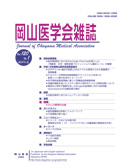

Journal of Okayama Medical Association
Published by Okayama Medical Association<Availability>
Full-text articles are available 3 years after publication.
Permalink : http://escholarship.lib.okayama-u.ac.jp/18991
On the Active Estrogen in the Urine of Uterine Cancer Patient
Mori, Kumehiko
Published Date
1958-05-31
Abstract
For a quite long time a considerable attention has been focused on the relationship between the etiology of cancer and estrogen, and experimental and clinical studies have been conducted from various angles. However, studies on this problem by a direct quantitative analysis of estrogen are still meager. The methods of quantitative analysis of estrogen, on the other hand, namely, both the biological and the chemical determinations, have recently been so improved that it is now possible to conduct microdetection of estrogen. Moreover, by chemical determination estrogne can now be estimated so that the actual estrogen metabolism in vivo is being clarified. Therefore, an attempt has been made to explore the relationship between cancer and estrogen. First women over three years past menopause were selected so as to avoid the effect of variations in menstrual period as well as the effect of fluctuations in estrogen at menopause. Active estrogen in urine was then determined in order to estimate indirectly the active estrogen in vivo. These procedures were undertaken for both the non-cancer and the cancer cases for the comparison: and at the same time the active estrogen in cases with cervical cancer were studied in detail by dividing the duration of cancer progress into various stages. The purpose of this paper is to present the findings obtained from the foregoing study. 1) As for the sensitivity of the biological microdetection method devised by us and applied in experimental animals that proved to be over 60 per cent positive, it has been possible to detect 0.00075 γ estradiol. Moreover, in the application of this method for comparative study of estrogen excreted into urine, it has been found that the use of urine during 12 hours at night is simpler and more adequate. 2) As for the average estrogen quantity, cases with uterine cancer tend to show an increase as compared with that in non-cancer cases; in comparing solely the cases with cervical cancer the quantity likewise tends to show an increase in contrast with non-cancer cases; and in the cases with cervical cancer at various progressive stages it has been observed that the further advanced the cancer the greater tends to be the estrogen excreted in urine. 3) Among the patients with cervical cancer, only 17.6 per cent showed a marked abnormality in estrogen as compared with non-cancer cases; and the majority of them showed estrogen distribution within the range of that in non-cancer cases. 4) Excepting these abnormally increased cases, and designating those that clearly surpassed the average of estrogen content over the control (non-cancer group) as a relatively increased group, the rate of incidence of this relatively-increased group is higher in the cases with cervical cancer than that in the control; and the rate of such incidence is higher in a more advanced case. 5) However, even in the cases of cervical cancers in stage Ⅱ and stage Ⅲ, there were some cases showing about the same proportion of relatively low quantity of estrogen as in the control; and these results rather coincided accidentally with those of disturbances observable in the liver function in the cervical cancer as already reported in the literature. In addition, in a single case in which the quantity of estrogen has been possible to compare with histological findings of ovarian lesions, as no appreciable decrease in estrogen quantity can be observed in comparison with the findings of ovarian lesions, it is assumed that the causative factor for estrogen increment exists outside the ovarian lesions. As for the causative factor the functions of the liver and of the adrenal cortex seem to play important role. However, as can be assumed from the results of experiments so far described, the disturbances in the liver functions appear to play a principal role in elevating the quantity of active estrogen in urine of cervical cancer patient. 6) As regards the relationship between the pattern of cancer growth and the size of visible part of carcinogenic focus on one hand and the quantity of estrogen on the other, there is nothing especially noteworthy to mention.
ISSN
0030-1558
NCID
AN00032489
